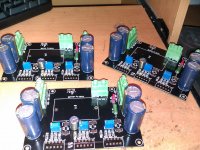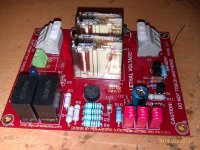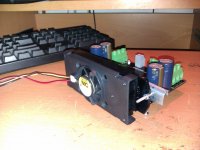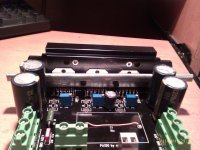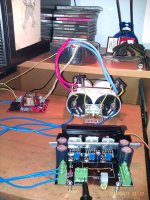BPA-150 + MyRef-C
I don't know what it is but it's got lights and it clicks.

Outside toroid transformers for MyRef amps. Center powers the BPA-150s.
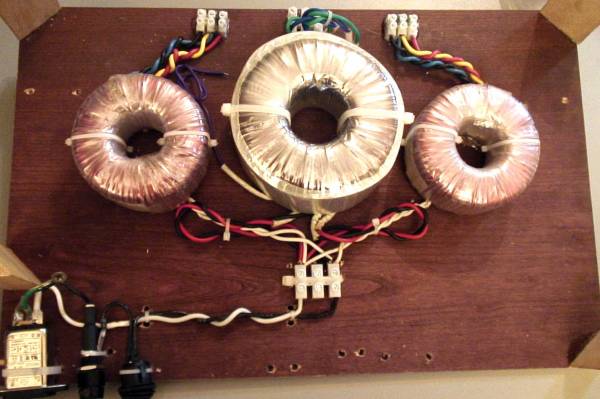
Arrangement will change to avoid toroid field being directly under MyRefs.

This is the full stack that will eventually be mounted in a standard 17" rack in a home studio.
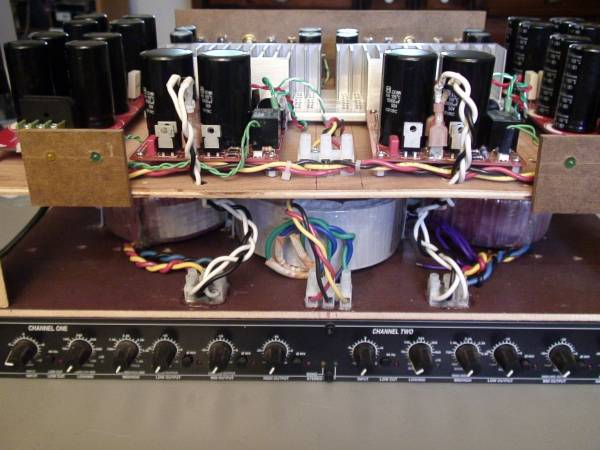
Trying to keep most wires close to the board which will be 1/16" steel plate in final version.

Amp and PS locations allow for shortest signal leads.
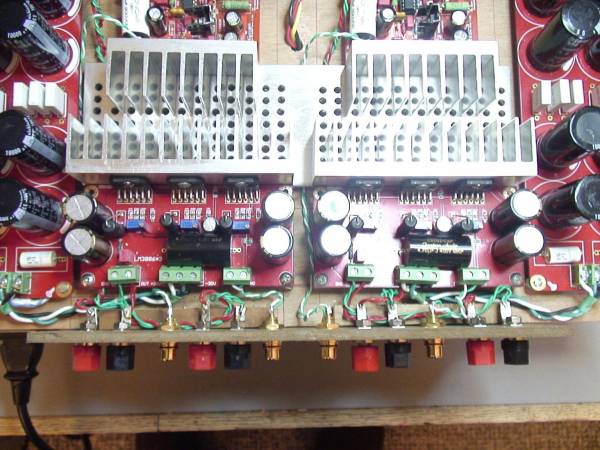
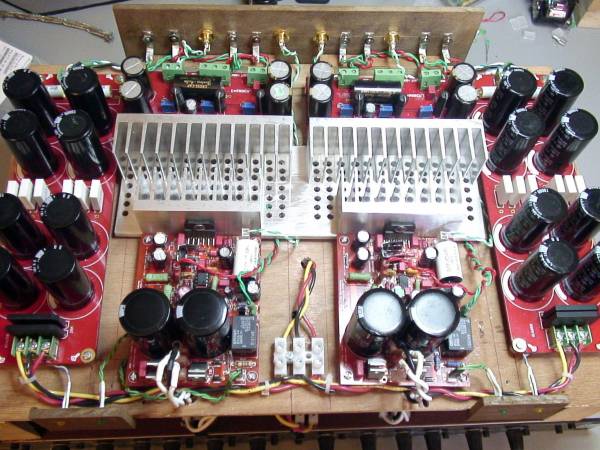
Heat sink has 3/16" clearance from board to aid air flow.
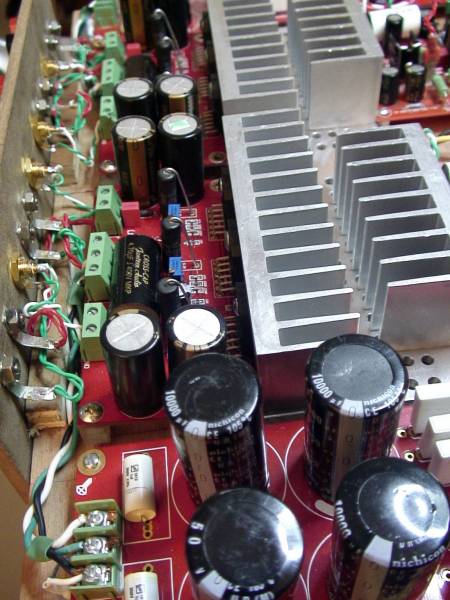
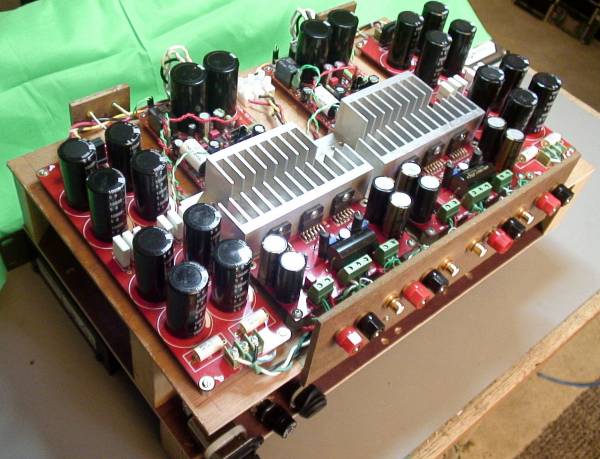
So no sparks or green smoke so far. BPA-50 LEDs were added with a 3.9K resistor across positive rail to ground. Next is custom cables to connect DBX crossover to amps.
After two hours heat sink stabilizes at 40C/102F without pushing music through system. May need small fan somewhere in the chassis.
I don't know what it is but it's got lights and it clicks.
Outside toroid transformers for MyRef amps. Center powers the BPA-150s.
Arrangement will change to avoid toroid field being directly under MyRefs.
This is the full stack that will eventually be mounted in a standard 17" rack in a home studio.
Trying to keep most wires close to the board which will be 1/16" steel plate in final version.
Amp and PS locations allow for shortest signal leads.
Heat sink has 3/16" clearance from board to aid air flow.
So no sparks or green smoke so far. BPA-50 LEDs were added with a 3.9K resistor across positive rail to ground. Next is custom cables to connect DBX crossover to amps.
After two hours heat sink stabilizes at 40C/102F without pushing music through system. May need small fan somewhere in the chassis.
Last edited:
Here you can see the finished boards.
-The red ones are two protection PCBs for inrush current protection, courtesy of Per-Anders
-One of the board mounted on a Pentium II heatsink for DC trimming and -testing purposes.
-And the whole testing setup.
-The red ones are two protection PCBs for inrush current protection, courtesy of Per-Anders
-One of the board mounted on a Pentium II heatsink for DC trimming and -testing purposes.
-And the whole testing setup.
Attachments
I look at this BPA150 layouts such as these, very nice by the way, and wonder how many boards are out there worldwide.
When I produced my first set of boards I email Alex for permission to use his property as I did with Jens and the Leach boards and Dr. Leach himself. Everyone here on the forum sees intellectual property rights as someones own property. '
I would just like to take this moment to thank all of you who selflessly allow me and others to use your hard work for out hobby. Thanks.
Now, Those last two posts with all the pictures attest to the time and hardwork involved in a good end project. The power supply pcb's and the protection circuit pcb's and the input pcb's all of this is making it professional. No loose wire and such. I also, like Peranders nice warning on the board about electrocuting ones self.
Keep sending those photos. I like them. Nice job.
Has anyone noticed a lack of new interest in this hobby. There does not seem to be much new stuff coming in to play with.
Tad
When I produced my first set of boards I email Alex for permission to use his property as I did with Jens and the Leach boards and Dr. Leach himself. Everyone here on the forum sees intellectual property rights as someones own property. '
I would just like to take this moment to thank all of you who selflessly allow me and others to use your hard work for out hobby. Thanks.
Now, Those last two posts with all the pictures attest to the time and hardwork involved in a good end project. The power supply pcb's and the protection circuit pcb's and the input pcb's all of this is making it professional. No loose wire and such. I also, like Peranders nice warning on the board about electrocuting ones self.
Keep sending those photos. I like them. Nice job.
Has anyone noticed a lack of new interest in this hobby. There does not seem to be much new stuff coming in to play with.
Tad
Hi,
I haven't read this entire thread yet but I was wondering if anybody had built something similar using two LM3886 instead of 6.... If so, what kind of power output could one expect with just two chips like this? I have no need for 300+ watts but I would be interested to hear what a two chip system I am describing would sound like. I have built several LM3886 based amps and have loved the results so far.
Also, thanks for the reply on the DrV boards...I purchased a set of the blank PCBs just now. I am planning to try to build a two chip like I am describing.
I haven't read this entire thread yet but I was wondering if anybody had built something similar using two LM3886 instead of 6.... If so, what kind of power output could one expect with just two chips like this? I have no need for 300+ watts but I would be interested to hear what a two chip system I am describing would sound like. I have built several LM3886 based amps and have loved the results so far.
Also, thanks for the reply on the DrV boards...I purchased a set of the blank PCBs just now. I am planning to try to build a two chip like I am describing.
Per-Anders These ones look awesome!Can somebody here lewd me to a source for the DRV134 driver boards/module?
Thanks,
Jeff
Audiosector have some pcb/kits that allows to set a bridge or parallel setup with the same PCB.
2 chips instead of 6.
Does that mean you are planning a PA100, or a BA100 or two channels of single chipamps?
Forgive my ignorance but I am not familiar with your terminology...my understanding of the BPA300 is it uses two banks of thee chips in parallel, each set of three "opposing" each other in opposite phase...my intentions are to use one chip "opposing" one other chip in opposite phase (instead of three in parallel, only one).....so signal to DRV134 then signal+ out to one chip and signal - out to the other, each chip driving it's respective terminal on my speaker. It would take a total of four chips (intend of twelve) for a stereo amp.... Hope that clarifies things.
So, in those arrangement what type pf power output would I be looking at, around 130wpc? Or is it a factor of four with 260wpc?
I thought you only need a pair of chips for a channel and when using more chips that is for driving lower impedance's, No?
OK I just reread and saw that the BPA150 has 3 chips on it already so a pair would be six 3886's in parallel.(BPA300 I think) And then only using 2 chips would be a PA100.
PA100 DIY 2x LM3886 in parallel gainclone audio amplifier
Bob, Tad or others do you think the 3886 would be fine playing ranges from 20hz-500hz?
I have finally decided what I am going to build speaker wise but need to bi-amp the speaker. The recommended wattage is anywhere from 2-200watts for 20-500hz. I would then just need about 2-40watts for the highs. So what wattage should I try for in making the 20-500hz?
I was thinking 100 watts would be PLENTY but I just want to make sure I build the amp with easily enough headroom. Normally I would think 3 db headroom but just wanted to ask to make sure what everyone's thoughts were on this matter. Maybe BPA300 or 200 if they have one per channel.
I think I would just make 2 separate amps of 3 channels each.(L/C/R) I am thinking that the standard BPA150 would be overkill for the highs, I do like having lots of headroom, but is this TOO much?
OK I just reread and saw that the BPA150 has 3 chips on it already so a pair would be six 3886's in parallel.(BPA300 I think) And then only using 2 chips would be a PA100.
PA100 DIY 2x LM3886 in parallel gainclone audio amplifier
Bob, Tad or others do you think the 3886 would be fine playing ranges from 20hz-500hz?
I have finally decided what I am going to build speaker wise but need to bi-amp the speaker. The recommended wattage is anywhere from 2-200watts for 20-500hz. I would then just need about 2-40watts for the highs. So what wattage should I try for in making the 20-500hz?
I was thinking 100 watts would be PLENTY but I just want to make sure I build the amp with easily enough headroom. Normally I would think 3 db headroom but just wanted to ask to make sure what everyone's thoughts were on this matter. Maybe BPA300 or 200 if they have one per channel.
I think I would just make 2 separate amps of 3 channels each.(L/C/R) I am thinking that the standard BPA150 would be overkill for the highs, I do like having lots of headroom, but is this TOO much?
Does that mean you are planning a PA100, or a BA100 or two channels of single chipamps?
look at the National datasheets and application notes for the chipamps you propose to use.Forgive my ignorance but I am not familiar with your terminology...
I aim for headroom of 15dB to 20dB. Some will aim as low as 10dB headroom if they are listening to music (audio signals) that are overly compressed.Normally I would think 3 db headroom but just wanted to ask to make sure what everyone's thoughts were on this matter.
I listen at less than half a watt and have at least 50W available.
If I want to listen a little louder, say 1W, then I would have 100W available.
If I want to turn it up loud, let's say 5W then I would accept a lower headroom and the more frequent clipping that may ensue, loss of quality in return for loud music.
These power examples would match with 88 to 90dB/W 8ohm speakers @ 2.5m
chrapladm,
I believe there is a bit of confusion with the word/concept of "power". Let me suggest the end result of a system is better understood with the term "sound pressure level" or SPL.
My original desire to build a bi-amp system was the fact that with an attenuator as the volume control device, I felt the need for a higher SPL "volume" for my personal preferences and the relatively inefficient speakers I was using. Over the weeks I learned that what I needed was actually a preamp or buffer to add an element of gain as opposed to using just an attenuator. To make a long story short, In a direct comparison the SPL of a one chip amp was almost identical to the SPL of my three chip build with the attenuator approach. I used that approach in a desire to keep the number of active electronic devices in the entire system as low as I could - thereby reducing the distortion and coloration possibilities.
Yesterday I played a new set of pipe organ pieces using the single chip MyRef being driven by a Lexicon Omega (PC usb sound device) attached to a laptop computer. I've also used a Carver C-1 preamp. In the same room the highest pipes sounded crystal clear and dynamic. At only ten o:clock on the Lexicon volume knob I was able to rattle the coffee cups three rooms away in the kitchen. So everything I could need - and more - was being produced from 20hz - 20khz with a single LM3886 amp - again with the same inefficient speakers. It wasn't more power or more watts that I needed but more correctly, more gain to drive the power amp.
I continue to develop the bi-amp/tri-amp build because using an active crossover is simply something I've always wanted to do - not from a need for more "Power/SPL".
Hope this helps clarify things a bit.
I believe there is a bit of confusion with the word/concept of "power". Let me suggest the end result of a system is better understood with the term "sound pressure level" or SPL.
My original desire to build a bi-amp system was the fact that with an attenuator as the volume control device, I felt the need for a higher SPL "volume" for my personal preferences and the relatively inefficient speakers I was using. Over the weeks I learned that what I needed was actually a preamp or buffer to add an element of gain as opposed to using just an attenuator. To make a long story short, In a direct comparison the SPL of a one chip amp was almost identical to the SPL of my three chip build with the attenuator approach. I used that approach in a desire to keep the number of active electronic devices in the entire system as low as I could - thereby reducing the distortion and coloration possibilities.
Yesterday I played a new set of pipe organ pieces using the single chip MyRef being driven by a Lexicon Omega (PC usb sound device) attached to a laptop computer. I've also used a Carver C-1 preamp. In the same room the highest pipes sounded crystal clear and dynamic. At only ten o:clock on the Lexicon volume knob I was able to rattle the coffee cups three rooms away in the kitchen. So everything I could need - and more - was being produced from 20hz - 20khz with a single LM3886 amp - again with the same inefficient speakers. It wasn't more power or more watts that I needed but more correctly, more gain to drive the power amp.
I continue to develop the bi-amp/tri-amp build because using an active crossover is simply something I've always wanted to do - not from a need for more "Power/SPL".
Hope this helps clarify things a bit.
Last edited:
I think so Bob. Because 15-20db would be insane for me. I was told along time ago to use rms power and atleast an amp that can deliver 3db more for headroom. SO I would need 5000 watts per speaker for my subs and to have 17.5-10db more WOW!!! that would be a LOT of power. I thought I was crazy. But I understand what you are saying Andrew T.
Now my speakers I am building Bob will be very efficient. A similar speaker combo has a 105db rating. I was only worried about the reserve power needed for sustained bass but if you are playing pipe organ music than I should be fine.(Telarc: Kunzel Pipe music??)
And thats also good to know because I could just build identical amps instead of different wattage ones and single 3886 would cut costs down also. I thought of building either a ALK design passive crossover or a crossover utilizing Rob Elliot's boards.
But I definitely want to see how yours turns out.
Now my speakers I am building Bob will be very efficient. A similar speaker combo has a 105db rating. I was only worried about the reserve power needed for sustained bass but if you are playing pipe organ music than I should be fine.(Telarc: Kunzel Pipe music??)
And thats also good to know because I could just build identical amps instead of different wattage ones and single 3886 would cut costs down also. I thought of building either a ALK design passive crossover or a crossover utilizing Rob Elliot's boards.
But I definitely want to see how yours turns out.
In my 7.1 Denon system there is a 68 pound Hi-Vi SP-10 driver in a 1.2 cuft sealed box (ala Sunfire by Carver) pushed by a 500 watt Bash sub amp. The only time I use it is when I want to hear the exaggerated LFE sounds on a few movies. There has never been a need to ad the sub to the system when using either the MyRefs or the BriagGTs for what I will call "Audiophile" listening.
Your mileage may vary !
Your mileage may vary !
Last edited:
Ya my mileage has varied a little. LOL
I have been through quite a few subs and searching for budget/value has been my goal since moving to Australia. Now I know exactly what I will need/want for HT and now will just work on refining the the power to the 5/7 channels. But yes I will only use my subs for HT. The mains go down plenty low enough for all music. Except some Kunzel stuff. 1812/Pipe organ ect.
I will probably end up going to a nice preamp in the far future once I get some amps made.
I have been through quite a few subs and searching for budget/value has been my goal since moving to Australia. Now I know exactly what I will need/want for HT and now will just work on refining the the power to the 5/7 channels. But yes I will only use my subs for HT. The mains go down plenty low enough for all music. Except some Kunzel stuff. 1812/Pipe organ ect.
I will probably end up going to a nice preamp in the far future once I get some amps made.
I only thought I would need a more powerful 3886 amp because I wanted to be able to coast along at reference volumes and loud listening. Then I would never stress the amp. But I think I will be fine with 70 watts roughly.
Is the signal from your Denon AVR enough for your 3886 amp for adequate volume?
Is the signal from your Denon AVR enough for your 3886 amp for adequate volume?
- Status
- This old topic is closed. If you want to reopen this topic, contact a moderator using the "Report Post" button.
- Home
- Group Buys
- BPA300 Round 2
